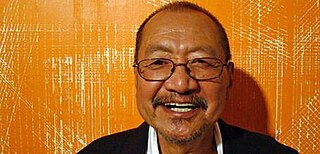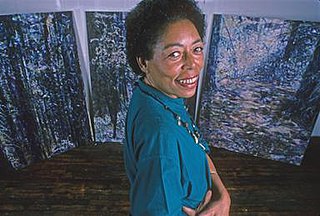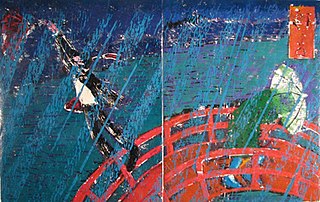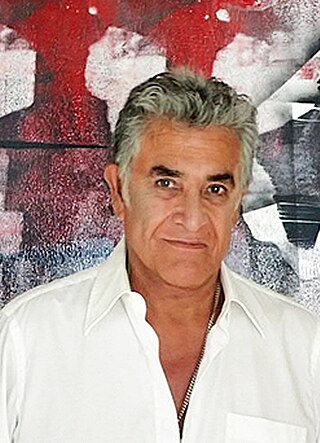The Bay Area Figurative Movement was a mid-20th-century art movement made up of a group of artists in the San Francisco Bay Area who abandoned working in the prevailing style of Abstract Expressionism in favor of a return to figuration in painting during the 1950s and onward into the 1960s.

Mary Henry, born Mary M. Dill, was an American artist whose work, most notably large oil paintings and acrylics but also prints, was characteristized by geometric abstraction. Many of her pieces are diptychs and some are triptychs. Some of her work resembles, variously, op art, constructivism, or even psychedelic art.
Sylvia Snowden is an African American abstract painter who works with acrylics, oil pastels, and mixed media to create textured works that convey the "feel of paint". Many museums have hosted her art in exhibits, while several have added her works to their permanent collections.
Betty Blayton was an American activist, advocate, artist, arts administrator and educator, and lecturer. As an artist, Blayton was an illustrator, painter, printmaker, and sculptor. She is best known for her works often described as "spiritual abstractions". Blayton was a founding member of the Studio Museum in Harlem and board secretary, co-founder and executive director of Harlem Children's Art Carnival (CAC), and a co-founder of Harlem Textile Works. She was also an advisor, consultant and board member to a variety of other arts and community-based service organizations and programs. Her abstract methods created a space for the viewer to insert themselves into the piece, allowing for self reflection, a central aspect of Blayton's work.

Carlos Villa was a Filipino-American visual artist, curator and faculty member in the Painting Department at the San Francisco Art Institute. His work often explored the meaning of cultural diversity and sought to expand awareness of multicultural issues in the arts.
Liz Craft is a Los Angeles installation artist and sculptor. She co-runs the Paradise Garage in Venice Beach, California. Her artwork has been exhibited internationally and collected by museums including the Los Angeles County Museum of Art, LACMA, and the Hammer Museum in Los Angeles.

Vivian E. Browne was an American artist. Born in Laurel, Florida, Browne was mostly known for her painting series called Little Men and her Africa series. She is also known for linking abstraction to nature in her tree paintings and in a series of abstract works made with layers of silk that were influenced by her travels to China. She was an activist, professor, and has received multiple awards for her work. According to her mother, Browne died at age 64 from bladder cancer.

Benny Alba is an artist who lives in Oakland, California.

Ynez Johnston was an American painter, sculptor, printmaker, and educator. Known for her work in painting, printmaking, and mixed media, Johnston was particularly inspired by Byzantine art, as well as Tibetan, Indian, Mexican, and Nepalese art from her extensive travels. Johnston was based in the San Francisco Bay Area in early life, and moved to Los Angeles in 1949.

Suzanne Jackson is an American visual artist, gallery owner, poet, dancer, educator, and set designer; with a career spanning five decades. Her work has been exhibited in museums and galleries around the world. Since the late 1960s, Jackson has dedicated her life to studio art with additional participation in theatre, teaching, arts administration, community life, and social activism. Jackson's oeuvre includes poetry, dance, theater, costume design, paintings, prints, and drawings.

Mary Evelyn Wrinch (1877–1969), was a Canadian artist who created miniature paintings, oil paintings, and block prints, sometimes inspired by the Northern Ontario landscape. She pioneered the 'Canadian style', painting landscapes with bold colours of the Algoma, Muskoka and Lake Superior regions, in situ. In her miniature paintings on ivory, she depicted her sitters with freshness and vitality. Her colour block prints are virtuoso examples of the medium.
Dewey Crumpler, is an American painter and educator. He was an associate professor at the San Francisco Art Institute.
Caitlin Cherry is an African-American painter, sculptor, and educator.

Robert Brokl is an American visual artist and activist based in the Bay Area, known for expressive woodblock printmaking and painting that has focused on the figure, landscape and travel for subject matter. His visual language combines the influences of German Expressionism, Japanese woodblock printing and the Bay Area Figurative Movement with a loosely autobiographical, Romantic interest in representing authentic personal experience, inner states and nature. Critics and curators characterize his style by its graphic line, expressive gestural brushwork, tactile surfaces and sensitivity to color, mood and light.
LaToya M. Hobbs is an American painter and printmaker best known for her large-scale portraits of Black women. She was born and raised in Little Rock, Arkansas. She earned her BA from the University of Arkansas at Little Rock and her MFA from Purdue University. Hobbs moved to Baltimore, Maryland later in her life, where she works as a professor at the Maryland Institute College of Art. She gained recognition for her portraiture and figurative imagery in the 2010s, receiving several travel grants and awards.

Sylvia Solochek Walters is an American artist and educator. She has produced drawings, paintings and collage works in her career, but is best known for complex woodcut prints created through the "reduction and stencil" process. Her work combines elements of realist, decorative and formalist art, flat and illusionistic space, and varied patterning and textures. She has largely focused on portraits, still lifes and domestic interiors, and collage-like combinations of personal symbolism—concerns that writers often align with early feminist art.
Nancy Genn is an American artist living and working in Berkeley, California known for works in a variety of media, including paintings, bronze sculpture, printmaking, and handmade paper rooted in the Japanese washi paper making tradition. Her work explores geometric abstraction, non-objective form, and calligraphic mark making, and features light, landscape, water, and architecture motifs. She is influenced by her extensive travels, and Asian craft, aesthetics and spiritual traditions.

Patricio Salvador Moreno Toro is a Chilean-born American visual artist and painter. His work is associated with abstract expressionism and incorporates Chilean forms and details.
Sylvia Lark (1947–1990) was a Native American/Seneca artist, curator, and educator. She best known as an Abstract expressionist painter and printmaker. Lark lived in the San Francisco Bay Area for many years.
Jean Halpert–Ryden was an American visual artist, active in Northern California. She primarily worked in painting, printmaking, and drawing; and her work was shown internationally. She was married to noted artist and designer, Edward Ryden.










